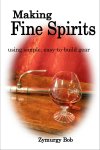Zymurgy Bob's Distillation Facts
An Overview of Potstilling

When a potstill is used to distill alcoholic beverages, an alcoholic wash is put in a boiler and brought to a boil. The vapor produced by that boiling is directed to a condenser, which cools the vapor, causing it to condense to a liquid. That liquid is the distillate, the end product of distillation.
Distillation has two major effects on the original wash. First, everything in that wash that cannot be vaporized is left in the boiler, and will not be present in the distillate. Second, because the wash is really a mixture of many liquids that can be vaporized (a property called "volatility"), such as water, ethanol and many flavoring compounds, distillation changes the concentrations of those volatile liquids in the distillate, continuously, and throughout the entire distilling run.
It's not really important, or even helpful, to the hobby potstiller, to understand the physical laws that control this sequential distillate change in any great depth. It's enough to know that the first, last, and every other drop out of that still has in it every volatile compound found in the wash, and at the same time each drop has different concentrations from the drop before and the drop after.
Much of the art of distilling with a potstill is about what parts or fractions of the still run the distiller saves for drinking, and what is discarded. To this end, the distiller wants to reduce the concentration of water in the distillate, and increase the concentration of ethanol, while minimizing the bad-tasting compounds and maximizing the good-tasting ones, all while watching the whole spectrum of these compounds come out of the still during a still run.
This process of saving some fractions while discarding others is called "making the cuts", and much of the art of distilling is aimed at making good cuts, and therefore good liquor.
While we usually don't think about it (or do it!), a "complete" still run would be a run where all of the wash is evaporated and the boiler is boiled dry, such that all the volatile liquids in the boiler end up in the distillate. In such a run, the distillate would end up with all the volatiles in exactly the same concentrations we started with in the wash, and that really doesn't do us any good. Fortunately for distillers, all the interesting compounds have mostly come through the still by the time about 25% of the wash has been vaporized. The remaining 75% of a "complete" still run would be mostly water, becoming purer water the closer to the end we get.
What makes distillation work for us is that we distillers simply stop distilling after that first (very roughly) 25%, and don't waste our time with all that water in the last 75%.
The Stripping Run
Since most washes are mostly water, a high-speed, indiscriminate still run, taking about 25% of the wash without even attempting to make any cuts, can get virtually all the alcohol and flavors out of the wash into the distillate. This first-run distillate is called "low wines", and can be further refined and separated by a later, slower, run, with careful cuts. Such a crude high-speed first distilling run is called a "stripping" run, or a "beer stripping" run, because it's particularly helpful as the first step in distilling a necessarily low-alcohol beer into a high-alcohol whiskey.
The Spirit Run
If the stripping run's purpose is simply to "strip" all the important compounds, good and bad, from most of the water in a wash, the spirit run's purpose is to separate the distillate into "fractions", distillate samples, each with a different mixture of ethanol, water, and all those flavoring compounds. Having all these fractions, the distiller can decide which fractions should become part of the finished spirit, and which fractions should be set aside for other uses.
A major part of the distiller's art is how these fractions are accepted or rejected. Using his nose, palate, and experience, the distiller judges each of the fractions from a slow, careful distillation, and his judgement determines the final quality of the whiskey, rum, brandy or other liquor. This process of judging and blending or discarding is called "making the cuts".
An easy way for either a new distiller, or an experienced distiller distilling something new, to approach making the cuts, is to collect the spirit run's output sequentially in small labeled containers. Each container has its number in the sequence, the head temperature range over which it was collected, and the alcoholometer readings for that range. For most new distillers, making judgements real-time at the still's output usually does not work as well as comparing the fractions at a later time. In that light, I like to make the cuts the day after distillation, although it's still highly instructive to taste the still's output as it emerges; for that reason, good distillers will have teaspoons handy when the still is turned on.
When Do We Strip, and When Do We Do a Spirit Run?
At its extremes, the choice is between quickly stripping large amounts of low-alcohol wash, and doing slower spirit runs on smaller quantities of higher-alcohol wash. Of course, this means that the output of a stripping run, low wines, is the perfect input to a spirit run, and that's how distillation is often done.
For a hobbyist, however, reality changes things a bit. For instance, beers for a stripping run are easily made in large quantities, while getting enough of a particular fruit to make quantities suitable for a strip-then-spirit run can be difficult and/or infrequent. Because of that, often the hobby distiller has only enough fruit wine to make a single still run, and that run has to be a spirit run to get real drinkable product.

